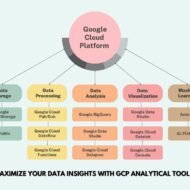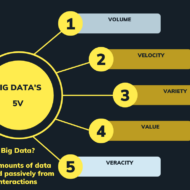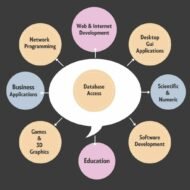Posted by Managementguru in Business Management, Data Science, How To, Technology
on Mar 21st, 2023 | 0 comments

In today’s data-driven world, businesses must maximize their data to gain a competitive edge. With Google Cloud Platform (GCP) Analytics, businesses can analyze and gain insights from their data to make informed decisions and drive business growth. This blog will explore how businesses can maximize their data insights with gcp analytics. Understanding Google Cloud Platform Analytics Google Cloud Platform (GCP) Analytics is a suite of tools and services that allow businesses to collect, process, analyze, and visualize their data. This Analytics provides various solutions, including real-time analytics, data warehousing, and machine learning. With this data, businesses can make data-driven decisions, optimize business processes, and gain a competitive edge. Here are some ways businesses can maximize their data insights with Google Cloud Platform Analytics: 1. Collect and Store Data The first step to gaining insights from your data is to collect and store it in a centralized location. Analytics offers several data collection solutions, including Google Cloud Storage, SQL, and Bigtable. With Google Analytics, businesses can store data in a scalable and secure manner, making it easier to analyze and gain insights. 2. Process Data in Real-time Real-time analytics can give businesses valuable insights and enable them to make informed decisions quickly. Google Analytics offers several solutions for real-time analytics, including Google Cloud Pub/Sub, Google Cloud Dataflow, and Google Cloud Functions. With these tools, businesses can analyze streaming data in real time, quickly detecting and responding to issues. 3. Analyze Data Google Cloud Platform Analytics offers several tools for analyzing data, including Google BigQuery, Google Data Studio, and Google Cloud Dataproc. These tools allow businesses to analyze large volumes of data and gain valuable insights into customer behavior, business processes, and more. Businesses can identify trends and patterns by analyzing data, optimizing operations, and improving customer experience. 4. Visualize Data Data visualization is essential to data analysis, allowing businesses to communicate insights effectively. Google Cloud Platform Analytics offers several tools for data visualization, including Google Data Studio, Google Cloud Datalab, and Google Cloud Console. With these tools, businesses can create interactive dashboards, charts, and graphs, enabling them to communicate insights to stakeholders effectively. 5. Leverage Machine Learning Google Analytics offers a suite of machine learning tools, such as AutoML and AI Platform, which can help businesses extract valuable insights from their data. Businesses can easily build and deploy models that perform tasks such as predictive analytics, anomaly detection, and natural language processing using these tools. Machine learning can also help automate data cleaning and classification tasks, saving valuable time and resources. 6. Use Visualization Tools Google Cloud Platform Analytics offers a range of data visualization tools, such as Data Studio and Looker, which can help businesses present their data in a more engaging and intuitive way. These tools allow businesses to create interactive dashboards, reports, and charts that can be easily shared with stakeholders. Data visualization can help businesses uncover patterns and insights that might not be immediately apparent in raw data and can be particularly useful for identifying trends and making informed decisions. 7. Use Machine Learning Machine learning is a powerful tool for gaining insights from data and automating business processes. Google Cloud Platform Analytics offers several solutions for machine learning, including Google Cloud AutoML, Google Cloud AI Platform, and TensorFlow. With these tools, businesses can build custom machine-learning models and automate fraud detection, customer segmentation, and predictive maintenance tasks. In conclusion, gcp analytics is a powerful suite of tools and services to help businesses maximize their data insights. By collecting and storing data, processing data in real time, analyzing data, visualizing data, and using machine learning, businesses can gain valuable insights into customer behavior, business processes, and...

Posted by Managementguru in Business Management, Data Science, E Commerce, Technology
on Sep 19th, 2022 | 0 comments

The combination of data analytics and cloud computing is so potent that it may boost business income while lowering investment expenses. There is little doubt that the rise of e-commerce or electronic commerce has completely changed the operating models of firms across industries. MSME’s are the backbones of an economy MSME or micro, small, and medium firms have been the backbone of the Indian economy- creating jobs and contributing considerably to the country’s GDP. “Without big data analytics, companies are blind and deaf, wandering out onto the web like deer on a freeway.” Geoffrey Moore Small businesses in particular have discovered a new way to sell their products and services as well as broaden their reach to include people from all across the country and across borders. Introduction of the internet and e-commerce platforms has greatly expanded the breadth of these businesses’ clientele. Use Data Analytics to track return on investment Data analytics another digital development have made it possible for MSMEs to track the return on investment – R O I . Businesses can obtain and analyse crucial client data, such as time spent on each web page, orders placed, and transactions made over time. This assists them in making necessary changes to their marketing plan/ product listing etc. As a result, they can improve the whole consumer experience. What is predictive analytics? Predictive analytics is the science of converting data sets into forecasts and decisions. It is a subset of advanced analytics that uses current data points to estimate the possibility of specific events and provide company leaders with a blueprint to follow. Predictive analytics technologies can be used to predict the success of future products, reduce customer turnover, and detect and prevent fraud. Every firm from apparel retailers to aeroplane manufacturers needs to be able to turn data into actionable insights in order to survive and...

Posted by Managementguru in Data Science, How To, Learning, Programming Languages, Technology, Web Development, Website Design
on Feb 28th, 2022 | 0 comments

Python is not a dying language. If anything it seems to be growing and growing and growing. To get some programming experience under your belt, learn Python. Python has its own elegance. Does Python Langauage Has Future? FYI, future and present programmers, Python is becoming the first-choice language for learning it to get “actual jobs.” Python Topping the List in Top 10 Programming Languages in 2022 It is an object-oriented, flexible, general-purpose programming language created 30 years ago by Guido van Rossum. This technology is used in the development of applications such as: Instagram, Pinterest, Disqus, Uber, Reddit, Dropbox, Spotify, Google Search, Youtube and many more. Therefore, skilled Python programmers are highly sought after by IT recruitment agencies. Its popularity is underlined by the fact that In 2021 Python was the top programming language in TIOBE and PYPL Index. It can be assumed that this tendency will continue. Python Applications Python Advantages High levelSimpleOpen sourceGui programmingLarge standard libraryExpressive languageObject orientedInterpreted Downside Speed limitationsWeak in mobile computing and browsersDesign restrictionsUnder-developed data base access layers The programming language provides a great starting point for beginners. If you’re looking for one of the more user-friendly and popular coding languages to learn, you should definitely try Python! 10 Companies Using Python Scope Career in Data Science or AI industryWe DevelopmentFull-stack Python Developers in Startups Difficulty level: Easy to learn. One of the best programming languages for beginners. Key Takeaway: As a professional skilled in python, you will have your chance of working with one of your dream companies. What Does the Future have in Store for Python Professionals? Businesses across the world are looking for expert Python professionals who can satisfy the needs of their clients. Data science, big data, and networking are three areas where the python application and growth shall be substantial in the years to come. Average Salary Levels of a Skilled Python Programmer in India: Entry-level Python developer – ₹427,293. Mid-level Python developer – ₹909,818. Experienced Python developer – ₹1,150,000. Python Developer Salary Comparison in US References: Top 10 Programming Languages in 2022Best Programming Languages to Learn in 2022Career Opportunities in Python: Everything You Need To Know [2022]Python Developer Average Salary in United States...






